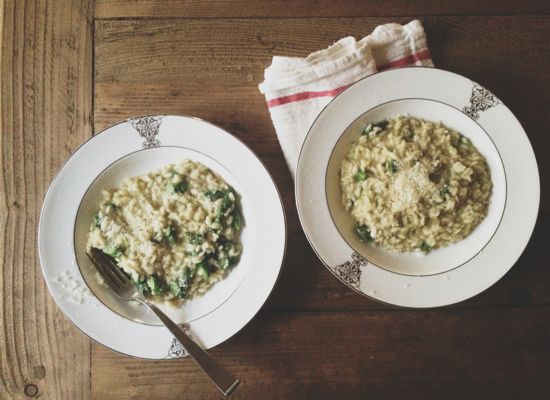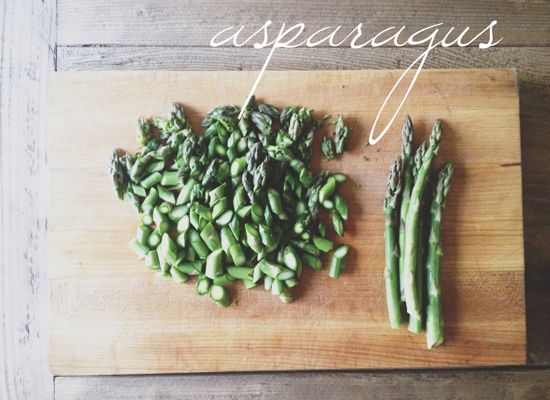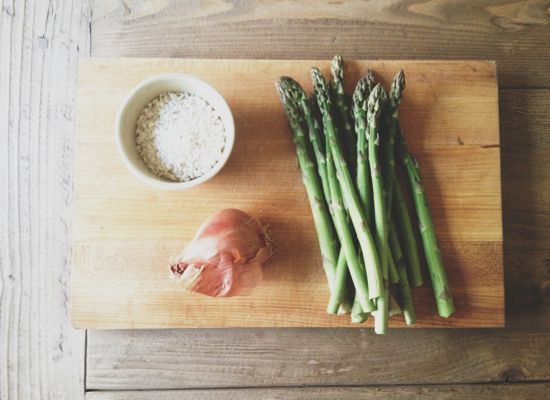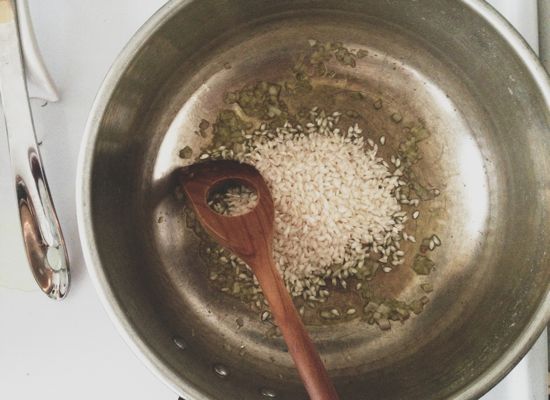
A couple of years ago, someone asked me what my signature dish was, and without hesitation, I replied with risotto. It surprises me now, because when I first started cooking, risotto was one of my least favorite things to make. I thought all the stirring and waiting wasn't worth my time. I lacked patience. I didn't see the beauty in the process. These are lessons I've learned now, but as a young, inexperienced cook, I didn't find value suspended in the grains of rice, but a pan filled with great risk. Risotto, as you may know, benefits from a good amount of loving attention. If you drift away and let the liquid absorb too much, the rice may stick to the bottom of the pan, or even worse, burn.
Once I warmed to the idea of maintaining constant watch on the stove, I still wasn't confident enough to know risotto's nuances. I wasn't certain if the rice was done, if it needed or less stock, or how much cheese to add. But with time, patience, and practice, comes intuition. Today, I just know when the rice is done. Then, I give the pan a triumphant shake, melt the butter and Parmesan, and whip the rice around with a wooden spoon until it flows like a river over smooth rocks. I always smile when I eat it, too.

I've made risotto in every season. Corn and tomatoes in the summer, pumpkin in the fall, cauliflower and brown butter in the winter, and asparagus and peas in the spring. When I read James McMichael's poem "The Vegetables" (excerpted below), I lingered over the asparagus section, dreaming up a bright, springtime risotto to enjoy alongside.
Excerpted from "The Vegetables"
by James McMichael
The Asparagus
She sent packs of great beasts to pass
Over him, trailing belly-fur and dust,
Bending their nostrils to his frail spear.
This was to toughen him. For what?
Stupidly, like a squirrel, standing up,
Looking here and there, looking to all sides,
He is cut down and taken away.
She can smell him steaming, his crowns
Already tender, his spine giving in.
Now he is threatening to wither terribly,
And slip from the water altogether,
And billow through the kitchen like prayer.
James McMichael, "The Vegetables" from The World At Large: New and Selected Poems. © 1996 by The University of Chicago. All rights reserved. Reprinted with permission from the publisher.
Here we find an omniscient speaker, watching over the garden and recounting the intimate story of how the asparagus was grown. From the first line, I love the imagery, and am especially fond of how we watch the asparagus being cooked, its "spine giving in."
To you and me, a squirrel is hardly a nuisance, but to something like the tip of an asparagus spear, a squirrel can become a "great beast." After meeting the squirrel, there is something to grab on to. Although we find the asparagus wondering what purpose he serves in this world, and why the squirrel was sent to torment him, it's more a reflection of our own uncertainties. We often ask these same questions ourselves. Why this path? Why this obstacle?


In the second stanza, the asparagus begins its journey from farm to table, which speaks to the relatively short growing season. Like rhubarb or strawberries, so much spring produce is a lesson in embracing the present. We can't sit idle saying next week I'll make the rhubarb crumble, or next week I'll make the shortcakes. The gifts are here for a brief time, and unless we want to risk them withering, slipping from our grasps, and billowing "through the kitchen like a prayer," we'd better get outside.
ASPARAGUS RISOTTO
Whipping cream is a new addition to my risotto ritual. However, it's a completely optional step. You can achieve perfectly creamy risotto without it, but if you're feeling extra decadent, whip it at the last minute and fold it into the rice before serving. I promise you'll love it.
1 bunch asparagus
6 to 8 cups vegetable stock
1 shallot, minced
2 cups Carnaroli rice
1 cup white wine
2 tablespoons unsalted butter
1/4 cup freshly grated Parmesan cheese, plus more for serving
1/3 cup heavy cream, whipped to soft peaks
Kosher salt
Chives, for garnish
Gently snap the asparagus spears where the stem naturally breaks; chop into 1/2-inch pieces. Salt a medium pot of boiling water and add the asparagus. Cook for 2-3 minutes, until just tender; shock in an ice bath to preserve the color. Puree half of the asparagus in a food processor with a tablespoon or two of cooking liquid; set aside.
Place the stock on a low simmer and keep a ladle nearby. Heat 2 tablespoons of oil in a deep, heavy saute pan over medium heat. Add the shallot and cook for 2-3 minutes, until translucent; do not let them brown. Stir in the rice and toast for 1-2 minutes.
Pour in the wine and let simmer until the liquid is mostly absorbed; continue scraping the pan so the rice doesn't stick. Season with a pinch of salt, then begin adding stock a ladle at a time, stirring often, and allowing most of the liquid to be absorbed before adding more. You'll want to add the reserved asparagus puree as one of the last ladles of liquid. The rice is cooked once the grains are al dente (fully cooked, but with a soft bite on the inside), about 20 minutes.
Turn off the heat and vigorously beat in the butter and cheese with a wooden spoon. Add the whipped cream and stir; season with salt if needed. Stir in the remaining asparagus spears and serve immediately, garnished with chives and additional Parmesan cheese.

